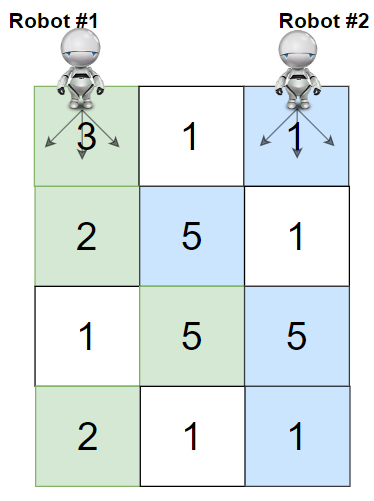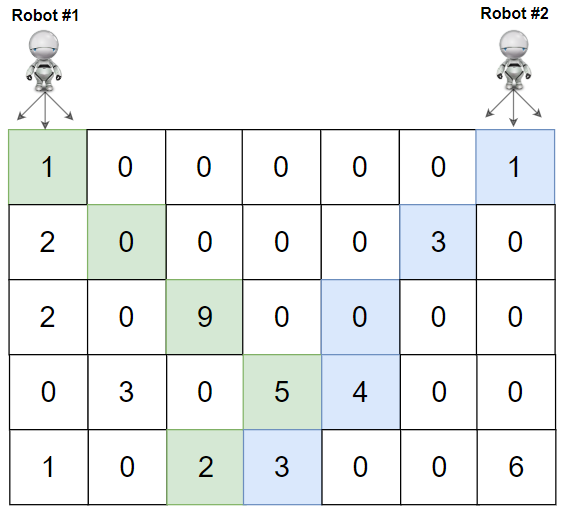You are given a rows x cols matrix grid representing a field of cherries where grid[i][j] represents the number of cherries that you can collect from the (i, j) cell.
You have two robots that can collect cherries for you:
- Robot #1 is located at the top-left corner
(0, 0), and - Robot #2 is located at the top-right corner
(0, cols - 1).
Return the maximum number of cherries collection using both robots by following the rules below:
- From a cell
(i, j), robots can move to cell(i + 1, j - 1),(i + 1, j), or(i + 1, j + 1). - When any robot passes through a cell, It picks up all cherries, and the cell becomes an empty cell.
- When both robots stay in the same cell, only one takes the cherries.
- Both robots cannot move outside of the grid at any moment.
- Both robots should reach the bottom row in
grid.
Example 1:
Input: grid = [[3,1,1],[2,5,1],[1,5,5],[2,1,1]] Output: 24 Explanation: Path of robot #1 and #2 are described in color green and blue respectively. Cherries taken by Robot #1, (3 + 2 + 5 + 2) = 12. Cherries taken by Robot #2, (1 + 5 + 5 + 1) = 12. Total of cherries: 12 + 12 = 24.
Example 2:
Input: grid = [[1,0,0,0,0,0,1],[2,0,0,0,0,3,0],[2,0,9,0,0,0,0],[0,3,0,5,4,0,0],[1,0,2,3,0,0,6]] Output: 28 Explanation: Path of robot #1 and #2 are described in color green and blue respectively. Cherries taken by Robot #1, (1 + 9 + 5 + 2) = 17. Cherries taken by Robot #2, (1 + 3 + 4 + 3) = 11. Total of cherries: 17 + 11 = 28.
Constraints:
rows == grid.lengthcols == grid[i].length2 <= rows, cols <= 700 <= grid[i][j] <= 100
Use dynammic programming, define dp[i][j1][j2]: The maximum cherries that both robots can take starting on the ith row, and column j1 and j2 of Robot 1 and 2 respectively.
class Solution:
def cherryPickup(self, grid: List[List[int]]) -> int:
m, n = len(grid), len(grid[0])
dp = [[[0] * n for _ in range(n)] for _ in range(m)]
valid = [[[False] * n for _ in range(n)] for _ in range(m)]
dp[0][0][n - 1] = grid[0][0] + grid[0][n - 1]
valid[0][0][n - 1] = True
for i in range(1, m):
for j1 in range(n):
for j2 in range(n):
t = grid[i][j1]
if j1 != j2:
t += grid[i][j2]
ok = False
for y1 in range(j1 - 1, j1 + 2):
for y2 in range(j2 - 1, j2 + 2):
if 0 <= y1 < n and 0 <= y2 < n and valid[i - 1][y1][y2]:
dp[i][j1][j2] = max(
dp[i][j1][j2], dp[i - 1][y1][y2] + t
)
ok = True
valid[i][j1][j2] = ok
return max(dp[m - 1][j1][j2] for j1 in range(n) for j2 in range(n))class Solution {
public int cherryPickup(int[][] grid) {
int m = grid.length;
int n = grid[0].length;
int[][][] dp = new int[m][n][n];
boolean[][][] valid = new boolean[m][n][n];
dp[0][0][n - 1] = grid[0][0] + grid[0][n - 1];
valid[0][0][n - 1] = true;
for (int i = 1; i < m; ++i) {
for (int j1 = 0; j1 < n; ++j1) {
for (int j2 = 0; j2 < n; ++j2) {
int t = grid[i][j1];
if (j1 != j2) {
t += grid[i][j2];
}
boolean ok = false;
for (int y1 = j1 - 1; y1 <= j1 + 1; ++y1) {
for (int y2 = j2 - 1; y2 <= j2 + 1; ++y2) {
if (y1 >= 0 && y1 < n && y2 >= 0 && y2 < n && valid[i - 1][y1][y2]) {
dp[i][j1][j2] = Math.max(dp[i][j1][j2], dp[i - 1][y1][y2] + t);
ok = true;
}
}
}
valid[i][j1][j2] = ok;
}
}
}
int ans = 0;
for (int j1 = 0; j1 < n; ++j1) {
for (int j2 = 0; j2 < n; ++j2) {
ans = Math.max(ans, dp[m - 1][j1][j2]);
}
}
return ans;
}
}class Solution {
public:
int cherryPickup(vector<vector<int>>& grid) {
int m = grid.size(), n = grid[0].size();
vector<vector<vector<int>>> dp(m, vector<vector<int>>(n, vector<int>(n)));
vector<vector<vector<bool>>> valid(m, vector<vector<bool>>(n, vector<bool>(n)));
dp[0][0][n - 1] = grid[0][0] + grid[0][n - 1];
valid[0][0][n - 1] = true;
for (int i = 1; i < m; ++i) {
for (int j1 = 0; j1 < n; ++j1) {
for (int j2 = 0; j2 < n; ++j2) {
int t = grid[i][j1];
if (j1 != j2) t += grid[i][j2];
bool ok = false;
for (int y1 = j1 - 1; y1 <= j1 + 1; ++y1)
for (int y2 = j2 - 1; y2 <= j2 + 1; ++y2)
if (y1 >= 0 && y1 < n && y2 >= 0 && y2 < n && valid[i - 1][y1][y2]) {
dp[i][j1][j2] = max(dp[i][j1][j2], dp[i - 1][y1][y2] + t);
ok = true;
}
valid[i][j1][j2] = ok;
}
}
}
int ans = 0;
for (int j1 = 0; j1 < n; ++j1)
for (int j2 = 0; j2 < n; ++j2)
ans = max(ans, dp[m - 1][j1][j2]);
return ans;
}
};func cherryPickup(grid [][]int) int {
m, n := len(grid), len(grid[0])
dp := make([][][]int, m)
valid := make([][][]bool, m)
for i := range dp {
dp[i] = make([][]int, n)
valid[i] = make([][]bool, n)
for j1 := range dp[i] {
dp[i][j1] = make([]int, n)
valid[i][j1] = make([]bool, n)
}
}
dp[0][0][n-1] = grid[0][0] + grid[0][n-1]
valid[0][0][n-1] = true
for i := 1; i < m; i++ {
for j1 := 0; j1 < n; j1++ {
for j2 := 0; j2 < n; j2++ {
t := grid[i][j1]
if j1 != j2 {
t += grid[i][j2]
}
ok := false
for y1 := j1 - 1; y1 <= j1+1; y1++ {
for y2 := j2 - 1; y2 <= j2+1; y2++ {
if y1 >= 0 && y1 < n && y2 >= 0 && y2 < n && valid[i-1][y1][y2] {
dp[i][j1][j2] = max(dp[i][j1][j2], dp[i-1][y1][y2]+t)
ok = true
}
}
}
valid[i][j1][j2] = ok
}
}
}
ans := 0
for j1 := 0; j1 < n; j1++ {
for j2 := 0; j2 < n; j2++ {
ans = max(ans, dp[m-1][j1][j2])
}
}
return ans
}
func max(a, b int) int {
if a > b {
return a
}
return b
}

